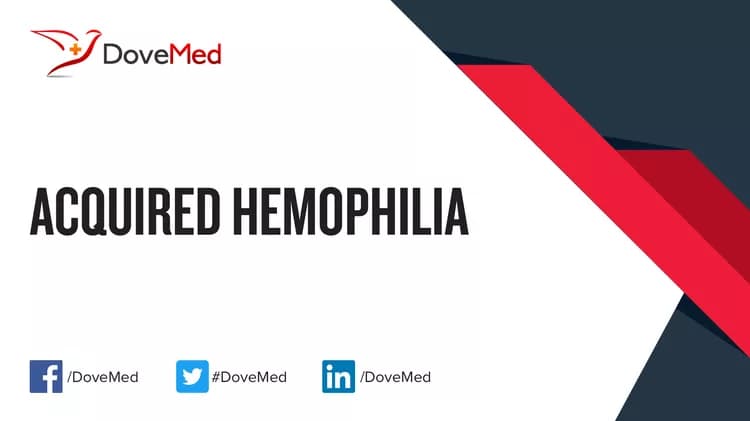What are the other Names for this Condition? (Also known as/Synonyms)
- Acquired Haemophilia
What is Acquired Hemophilia? (Definition/Background Information)
- Acquired Hemophilia is a bleeding disorder that interferes with the body's blood clotting process
- Although the condition can affect people of all ages, it generally occurs in older people (the median age of diagnosis is between 60 and 67 years)
- Acquired Hemophilia occurs when the body's immune system attacks and disables a certain protein that helps the blood clot
- About half of the cases are associated with other conditions, such as pregnancy, autoimmune disease, cancer, skin diseases, or allergic reactions to medications
- Signs and symptoms include prolonged bleeding, frequent nosebleeds, bruising throughout the body, solid swellings of congealed blood (hematomas), hematuria, and gastrointestinal or urologic bleeding
- Treatment is aimed at controlling bleeding episodes and addressing the underlying cause of the condition
(Source: Acquired Hemophilia; Genetic and Rare Diseases Information Center (GARD) of National Center for Advancing Translational Sciences (NCATS), USA.)
Who gets Acquired Hemophilia? (Age and Sex Distribution)
- Acquired Hemophilia is a rare bleeding disorder that typically affects older individuals
- Both males and females may be affected
- Worldwide, individuals of all racial and ethnic groups may be affected
What are the Risk Factors for Acquired Hemophilia? (Predisposing Factors)
The following are some risk factors for Acquired Hemophilia:
- Pregnancy
- Certain medications/drugs
- Autoimmune disorders
- Cancer
It is important to note that having a risk factor does not mean that one will get the condition. A risk factor increases one’s chances of getting a condition compared to an individual without the risk factors. Some risk factors are more important than others.
Also, not having a risk factor does not mean that an individual will not get the condition. It is always important to discuss the effect of risk factors with your healthcare provider.
What are the Causes of Acquired Hemophilia? (Etiology)
- Acquired Hemophilia is caused when the body's immune system attacks and disables a certain protein that helps the blood clot
- About half of the cases are associated with other conditions, such as pregnancy, autoimmune disease, cancer, skin diseases, or allergic reactions to medications
(Source: Acquired Hemophilia; Genetic and Rare Diseases Information Center (GARD) of National Center for Advancing Translational Sciences (NCATS), USA.)
What are the Signs and Symptoms of Acquired Hemophilia?
The signs and symptoms of Acquired Hemophilia may include:
- Autoimmune antibody positivity
- Anemia
- Prolonged partial thromboplastin time
- Reduced factor VIII activity
- Subcutaneous hemorrhage
- Intramuscular hematoma
- Gastrointestinal hemorrhage
- Hematuria
- Post-partum hemorrhage
- Intracranial hemorrhage
- Joint hemorrhage
(Source: Acquired Hemophilia; Genetic and Rare Diseases Information Center (GARD) of National Center for Advancing Translational Sciences (NCATS), USA.)
How is Acquired Hemophilia Diagnosed?
Acquired Hemophilia is diagnosed on the basis of the following information:
- Complete physical examination
- Thorough medical history evaluation
- Assessment of signs and symptoms
- Laboratory tests
- Imaging studies
- Biopsy studies, if necessary
Many clinical conditions may have similar signs and symptoms. Your healthcare provider may perform additional tests to rule out other clinical conditions to arrive at a definitive diagnosis.
What are the possible Complications of Acquired Hemophilia?
The complications of Acquired Hemophilia may include:
- Intra-cerebral hemorrhage; bleeding in the brain
- Joint deformities, due to persistent bleeding into the joint space
- Allergic reaction to infusion of blood products
- Internal bleeding in various organs
- Formation of hemophilic pseudotumor
- Relapse of bleeding episodes following treatment
Complications may occur with or without treatment, and in some cases, due to treatment also.
How is Acquired Hemophilia Treated?
The treatment for Acquired Hemophilia is decided on a case-by-case basis, and may depend on the underlying condition causing Acquired Hemophilia, and an individual’s tolerance to treatment. The following treatment methods may be employed:
- Treatment of the cause of Acquired Hemophilia
- Identifying triggers for bleeding and preventing bleeding episodes
- Controlling episodes of bleeding with the use of bypassing agents, which decrease the need for the deficient factor necessary for the clotting process
- Immune-suppression to remove autoantibodies, which may be accomplished by:
- Corticosteroids
- Cyclophosphamide
How can Acquired Hemophilia be Prevented?
- In some cases, Acquired Hemophilia may be prevented or its risk minimized, by undertaking suitable treatment of the underlying disease, by identifying and removing the trigger for the abnormal immune reaction
- Active research is currently being performed to explore the possibilities for treatment and prevention of disorders such as Acquired Hemophilia
- Regular medical screening at periodic intervals with tests and physical examinations are recommended
What is the Prognosis of Acquired Hemophilia? (Outcomes/Resolutions)
- The prognosis of Acquired Hemophilia is dependent upon the severity of the signs and symptoms and associated complications, if any
- Individuals with mild conditions have better prognosis than those with severe symptoms and complications
- Typically, the prognosis may be assessed on a case-by-case basis
Additional and Relevant Useful Information for Acquired Hemophilia:
The following DoveMed website link is a useful resource for additional information:
Related Articles
Test Your Knowledge
Asked by users
Related Centers
Related Specialties
Related Physicians
Related Procedures
Related Resources
Join DoveHubs
and connect with fellow professionals


0 Comments
Please log in to post a comment.